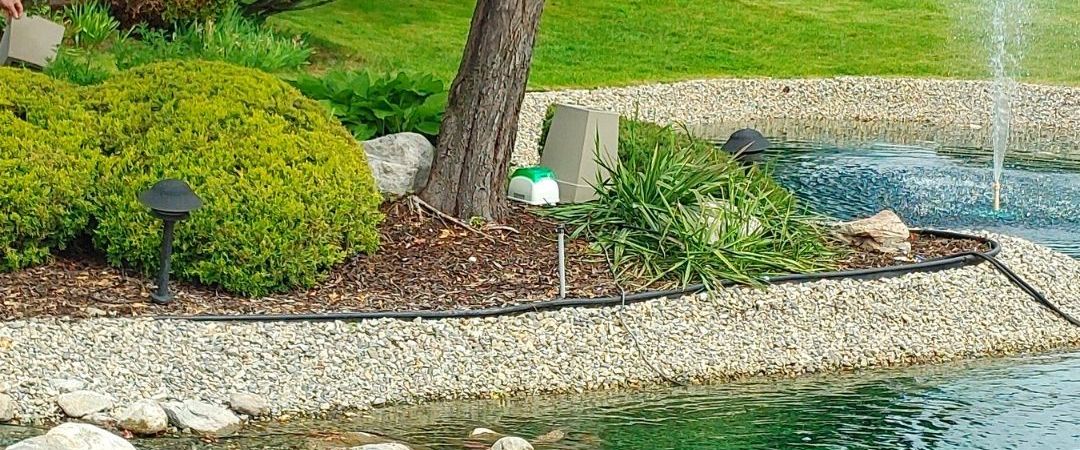
Pristine Ponds
If you sit on the board of a Homeowner Association, you take pride in how your community looks. From clean streets, green grass, and pristine ponds. Pond management is a challenge for any HOA, whether one pond, a series of connected ponds, or water hazards on a community golf course. This blog delves into common pond problems and solutions.
Nutrient Pollution
One of the primary challenges HOAs face when it comes to managing ponds is water quality. A healthy pond relies on a balance of nutrient control and sufficient oxygen levels.
HOA rules mandating a green and weed free lawn is fine for the lawn, but not for a pond! For flowers to bloom beautifully, fertilizers that contain nutrients like nitrogen, phosphorus, and potassium (NPK) are often used.
Even if care is taken to ensure fertilizer isn’t accidentally introduced to a pond, nutrient runoff will happen, whether from a sprinkler system or rainfall.
Wildlife including ducks, geese, and fish also contribute to nutrient pollution in ponds.
A pond is usually a closed aquatic ecosystem; no natural water source runs in or out, circulating water. This means nutrient levels can increase quickly, fueling algae blooms and unwanted aquatic plant growth.

The key is to naturally burn off nutrients before algae and aquatic vegetation can get out of control.
Oxygen Levels
With all the ranting about algae, you might be surprised that some algae in a pond is a good thing; algae provides oxygen via photosynthesis.
Maintaining sufficient oxygen levels is also important for pond health, especially fish.
Recall that nutrient pollution can quickly push algae from healthy levels to algae blooms. When an algae bloom dies, sinks, and decays on the bottom, oxygen is consumed.
A morass of unsightly, smelly, decaying algae blooms can make a pond unappealing to residents. Poor water quality can also lead to health problems for fish and other aquatic creatures that live in the pond.
To address depleted oxygen levels, many HOA’s install aerators or fountains to improve water circulation and oxygen levels.
Fountains add a touch of beauty to a pond for residents to enjoy. Keep in mind that fountains are a source of surface aeration, which can deter mosquito breeding, but bottom-up aeration is 8 to 10 times more effective at oxygenating a pond than surface aeration.
Unwanted Aquatic Plants
Lilies are lovely in small numbers, but nutrient pollution can quickly cause aquatic plants to overtake a pond. Unwanted aquatic plants can also be a nuisance for swimming and boating.
Invasive species can be even more troublesome as they can get a head start in the springtime, choking out indigenous species or the species of plant you prefer in your pond.
If an HOA pond is overrun by cattails and bulrushes, manual removal, root and all is the best course of action.
Beware of Chemical Quick Fixes
If you are dealing with a pond with very poor water quality, the temptation to bombard the pond with herbicides is understandable but not desirable. In addition to potentially being carcinogenic, herbicide use results in a huge amount of decaying organic matter that will further exacerbate poor water quality. This could lead to costly dredging.
Managing ponds can be a challenging task for HOAs. With time and patience, a natural approach is environmentally friendly and very effective.
Pond Care Program
Our 3 Step Pond Care Program is simple, eco-friendly, and cost effective.
Step one is to Renew with Nature’s Pond Conditioner, a blend of beneficial bacteria and enzymes that naturally consumes nutrients, helping control algae and aquatic plant growth.
Step two is to Revive with bottom-up aeration.

Oxygenating the entire water column from the bottom helps Nature’s Pond Conditioner to more effectively consume nutrients.
Our LD 1.5 Electric Aeration System is whisper quiet, making it ideal for the traditionally more shallow ponds located near homes in HOA communities.
Step three is to Remove any unwanted aquatic vegetation with our Cutter ‘N’ Rake.
Contact us today to learn more about how Koenders Water Solutions can help naturally manage the ponds in your HOA community.
Toll Free: 1-877-888-7707 or Contact Us
Click here to watch our video interview with Brenda Korby, Head of the Environmental Committee at Sandstone in Kelowna, BC.